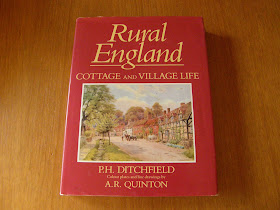In the same shop I eventually came across this book illustrated by Alfred Quinton and I enjoy it as much for the artwork as for the prose. In fact let's be honest here - the artwork is definitely the real reason that I love it!

When I'm in Suffolk I like to spend time exploring the lanes and villages that are off the main roads. Brent Eleigh is one of the places I came across and the view of this beautiful house is pretty much unchanged - only the geese and the horses are missing. If you click on the link it will take you to the post where I wrote about this village along with my photo of the house.
I would love to walk into this painting of Bossington in Somerset, it looks idyllic. I wonder whether it's still the lovely, quiet lane that appears here - I do hope so.
Gradually I came across one or two more books full of A.R.Quinton's paintings, some like the one above were second hand. Alfred Robert Quinton was born in 1853 in Peckham, London. He studied at Heatherley's Art School and by 1880 was sharing a studio with another artist at New Court, Lincoln's Inn. His watercolours were regularly exhibited at the Royal Academy and two of his paintings were bought by the then Duke and Duchess of York the parents of our present Queen. From the early 1900s Quinton travelled all round England painting local scenes which were published as postcards by the firm of J.Salmon Ltd. He paints the kind of rural scenes that appeal to me immensely and he has left a wonderful pictorial record of the England that existed before the advent of the car.
Another book of paintings, I enjoy just leafing through these and slipping back in time. It also goes with me if I'm travelling in areas where I know he painted so that I can try and find the villages and cottages.
This is Kersey in Suffolk then and now - certainly still recognizable as the place in the painting though the large tree has gone and the ever present cars and telegraph pole have appeared - neither improve the view! Most of the cottages have been done up too and have lost some of their charm as a result.
I discovered that there are lots of the Salmon postcards to be had so I have started collecting a few of the village and cottage ones. They are quite hard to find as many that are on ebay are views or of places like Oxford or Windsor. They are very nice but it's the rural ones that I really like.
This is my favourite book as it has a biography of A.R.Quinton along with lots of his paintings and a great deal more information about rural life in late Victorian and Edwardian times than appears in the other two books.
One of the paintings in the above book is this one of Cockington in Devon, it brings back a lot of happy memories for me as we always spent our annual holiday in either Paignton or Torquay when I was a little girl and we always went to Cockington. The painting is of the forge which dates back to the 1400s. When I was a child it was still a working forge, now I believe they sell miniature horseshoes to the tourists. Cockington is definitely one of those 'never go back' places I think, I'd rather remember the quiet, pretty village of my childhood.
Oh dear, I'm afraid I'm going to have to add all these to my book pile - the top of the pile too! I'm still ploughing through Mr Ditchfield's Vanishing England but I shall be rather glad when I've finished it and can move on to Alfred Quinton.
Blogger does seem to have come back to normal now so hopefully it will stay that way. I really didn't like being locked out of my own blog!





























